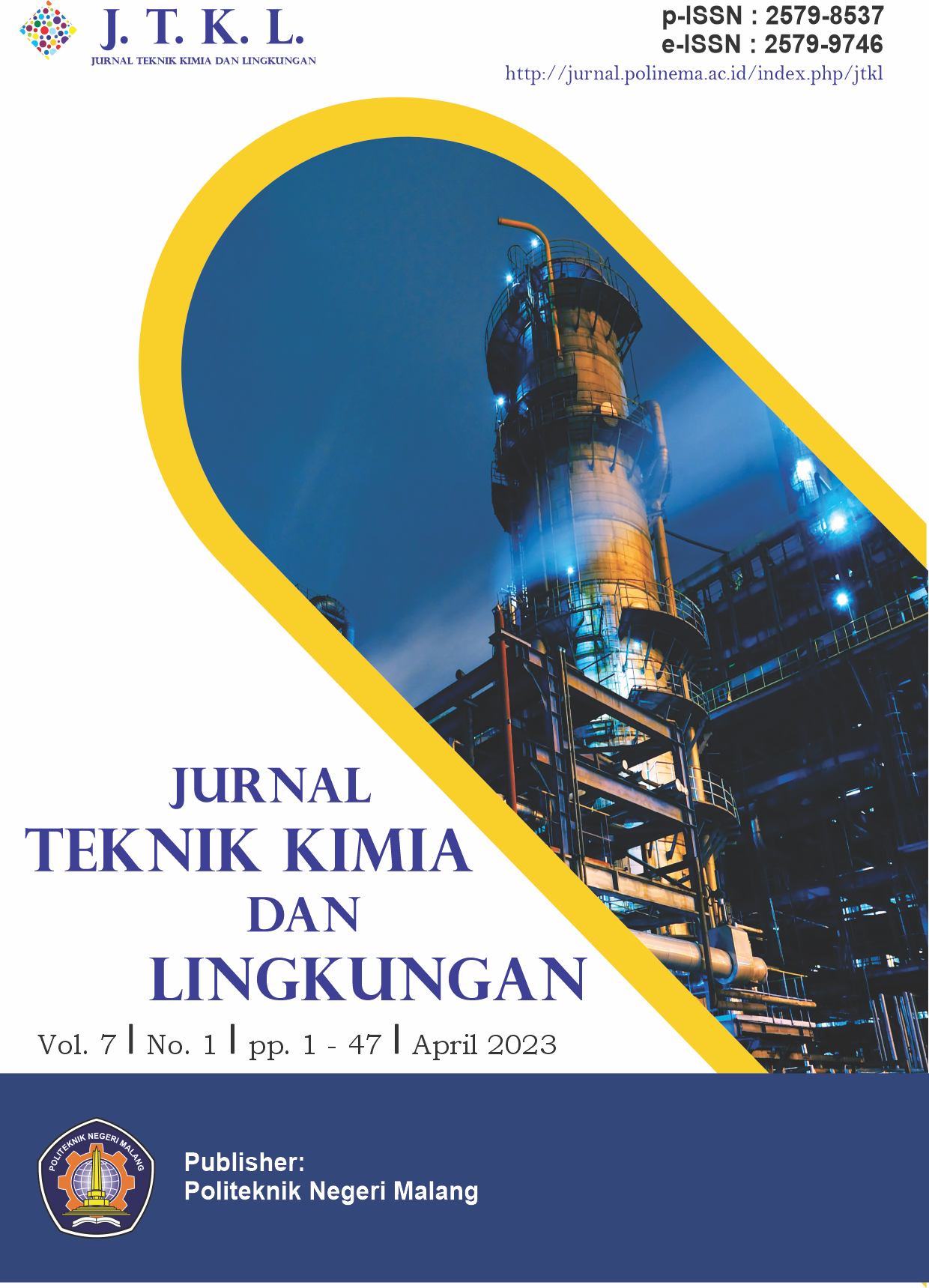Utilization of Yellow Shells (Cypraea moneta) in the Treatment of Cadmium Heavy Metal (Cd) Waste
DOI:
https://doi.org/10.33795/jtkl.v7i1.327Keywords:
adsorption, cadmium, Cypraea moneta, shellfish, wasteAbstract
Cadmium (Cd) metal is a heavy metal that can cause environmental pollution if its levels are above the environmental quality standard value. Generally, industrial wastes such as paper industry waste contain heavy metal Cd with levels reaching 0.026 ppm. Meanwhile, the quality standard for Cd metal in the environment is 0.005 ppm. For this reason, it is necessary to process it to reduce the levels of Cd metal in the waste before being discharged into the environment. One way that can be used to reduce the levels of Cd metal is by adsorption method using Cypraea moneta clamshells containing chitin. This study used variations in the particle size of the shellfish adsorbent of 6 and 12 mesh. In addition, the ratio of the amount of adsorbate and adsorbent (mg:mg) is 1 : 0.5x106; 1 : 1x106; and 1 : 1.5x106. Based on the results obtained, it showed that the use of shellfish as an adsorbent was able to reduce Cd metal content up to 89%.
References
Peraturan Menteri Kesehatan Republik Indonesia, Peraturan Menteri Kesehatan No. 2406 Tahun 2011 tentang Pedoman Umum Penggunaan Antibiotik, 2011.
S. Martin, W. Griswold, Human Health Effects of Heavy Metals, in Environmental Science and Technology Briefs for Citizens, issue. 15, 2009.
T. Can, Introduction to Bioinformatics, in miRNomics: MicroRNA Biology and Computational Analysis, Totowa, NJ: Humana Press, vol. 1107, pp. 51–71, 2014.
C. T. Chiou, Fundamentals of the Adsorption Theory, in Partition and Adsorption of Organic Contaminants in Environmental Systems, New Jersey: John Wiley & Sons, Inc., pp. 39–52, 2002.
M. Sperling, S. Xu, B. Welz, Determination of chromium(III) and chromium(VI) in water using flow injection on-line preconcentration with selective adsorption on activated alumina and flame atomic absorption spectrometric detection, Anal. Chem., vol. 64, no. 24, pp. 3101–3108, 1992.
W. L. McCabe, J. C. Smith, P. Harriott, Unit operations of chemical engineering, New York: McGraw-Hill Education, 1982.
S. N. A. Abas, M. H. S. Ismail, M. L. Kamal, S. Izhar, Adsorption process of heavy metals by low-cost adsorbent: A review, World Appl. Sci. J., vol. 28, no. 11, pp. 1518–1530, 2013.
A. M. Stephen, Food polysaccharides and their applications, 2nd Edition, Boca Raton: CRC Press, 2006.
A. Marlina, Pengembangan Metode Penentuan Kadar Timbal Dalam Kerang Hijau (Perna viridis L) Secara Spektrofotometri UV-Vis, in Prosiding Industrial Research Workshop and National Seminar, pp. 521–524, 2019.
L. Cundari, M. F. Melsi, C. Fiat, Pengaruh Waktu Sampling dan Ukuran Partikel Adsorben Terhadap Adsorpsi Kontinyu Limbah Kain Jumputan, Jurnal Teknik Kimia, vol. 22, no. 4, pp. 19–26, 2016.
Y. Sahan, K. Despramita, Y. Sultana, Penentuan Daya Serap Bentonit dan Kesetimbangan Adsorpsi Bentonit Terhadap Ion Cu(II), Chem. Prog., vol. 5, no. 2, pp. 93–99, 2012.
Y. Kawamura, H. Yoshida, S. Asai, H. Tanibe, Breakthrough curve for adsorption of mercury (II) on polyaminated highly porous chitosan beads, Water Sci. Technol., vol. 35, no. 7, pp. 97–105, 1997.
D. W. Sundstrom, H. E. Klei, Wastewater treatment. Englewood Cliffs, N.J: Prentice-Hall, 1979.
J. H. Nasution, I. Iriany, Pembuatan Adsorben dari Cangkang Kerang Bulu yang Diaktivasi Secara Termal sebagai Pengadsorpsi Fenol, Jurnal Teknik Kimia USU, vol. 4, no. 4, pp. 51–57, 2015.
Y. Suprianti, A. S. Kurniasetyawati, Regenerasi In-Situ Adsorben Karbon Aktif Tipe Granul dengan Metode Termal, J. Tek. Kim. Ling., vol. 3, no. 1, pp. 1–9, 2019.
Downloads
Published
Issue
Section
License
Copyright (c) 2023 Noor Isnaini Azkiya, Rosita Dwi Chrisnandari, Wianthi Septia Witasari

This work is licensed under a Creative Commons Attribution-NonCommercial 4.0 International License.







